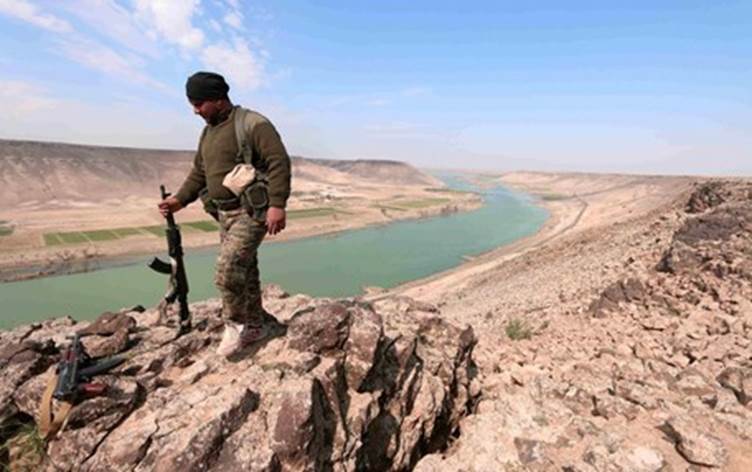The United States-led coalition and the Kurdish-led Syrian Democratic Forces (SDF) achieved significant headway in their campaign against Islamic State (ISIS) militants over the past week. The Americans airlifted SDF troops to the ISIS-occupied town of Tabqa and they reached the dam there on Friday, where they've reportedly encountered only light resistance. The dam is situated approximately forty kilometers west of Raqqa upstream on the Euphrates River.
However the dam is under strain and ISIS are claiming that it is on the verge of collapsing, reporting that all the equipment is down. The Syrian Observatory for Human Rights conflict monitor and the Raqqa is Being Slaughtered Silently activist group both reported on Sunday that ISIS is already ordering an evacuation of Raqqa. The United Nations warned in February that a breach in the dam would have fatal consequences for those downstream.
The UN report said that heavy rain and snowfall in late January coupled with ISIS's opening of three of the dam's turbines resulted in flooding. Also, US airstrikes damaged its entrance in January. ISIS are, predictably, blaming the airstrikes completely for the severe strain the dam is reportedly under at present.
“As per local experts, any further rise of the water level would submerge huge swaths of agricultural land along the river and could potentially damage the Tabqa Dam, which would have catastrophic humanitarian implications in all areas downstream,” the report said.
This situation is reminiscent of longstanding fears that the Mosul Dam will collapse. Engineers, including those who've worked on the dams construction, warned that the dam's collapse would drown hundreds-of-thousands in Mosul and the surrounding areas, affecting as far south as Baghdad. Mosul Dam also fell under ISIS control for a brief period but unlike Tabqa was rapidly recaptured by Kurdish Peshmerga forces supported by US coalition airstrikes in August 2014.
ISIS likely didn't divert resources to try and blow up that dam since at that time it ruled over Mosul with an iron fist and its enemies were in no shape to mount any substantial ground offensive operations against them in that key city. In Tabqa the situation is different. The SDF has Raqqa surrounded and “isolated”. The Syrian Kurdish People's Protection Units (YPG) – the main component of the SDF – told Reuters this month that the operation to take the city will begin next month. ISIS already began evacuating non-combat personnel from the city further south last month, where ISIS militants are besieging an isolated garrison of Syrian soldiers for control over the eastern city of Deir Ezzor – 140km southeast of Raqqa, which the UN says could also be affected by flooding from Tabqa.
Worst case scenario is that Tabqa Dam will completely collapse, flood Raqqa and kill tens-of-thousands and displace hundreds more. This would give ISIS a propaganda coup at a critical moment. They could slyly blame the ensuing humanitarian catastrophe on the US by claiming, which they've already begun doing, that the collapse was caused entirely by their airstrikes on the collapse, all the while conveniently ignoring their own tampering with the dam's turbines.
The crisis could also create the conditions which would enable the militants to weather the storm against them for the foreseeable future. They could do this by actively exploiting the crisis and further sow the seeds of chaos in the region. ISIS has proven time and again that it thrives on, and has a lot to gain from, chaos.
Even if this extreme outcome is a mild risk it should nevertheless necessitate a rapid emergency response. US combat engineers could be deployed to Tabqa to shore-up that earth-filled dam in the short-term. If its collapse does prove inevitable they could try and forestall it while delegating the UN, and other aid organizations, with the enormous task of ensuring Raqqa is fully evacuated and its residents sheltered elsewhere. Washington's talk of a safe zone for civilians in areas ravaged by ISIS's conquests, and the campaigns to rout them, could become twice as difficult in Syria amid such a crisis. Widespread destruction of the major cities in Iraq's western Anbar Province has left hundreds-of-thousands of Sunni Arab civilians sitting destitute in the desert, many of them wholly dependent on humanitarian assistance. The flooding of an already heavily bombed Raqqa could produce a similar, if not far worse, outcome.
The UN – which routinely warns it cannot afford to handle another large displacement crisis from Mosul into the Kurdistan Region – would unlikely be able to adequately respond in the short-term, never mind the long-term, to such an awesome tragedy. This could see Syria's de-facto autonomous northeastern Kurdish region facing a large influx of displaced Arabs. It too would need international assistance to help them cope with such an outcome.
Cooperation with Russian forces in Syria on humanitarian grounds – possibly done under the auspices of the UN – could see Moscow and Washington working together to successfully execute the logistical feat shoring up this dam could pose. This would at least forestall such an undesirable outcome, which would have negative ramifications for everyone aside from ISIS.
However the dam is under strain and ISIS are claiming that it is on the verge of collapsing, reporting that all the equipment is down. The Syrian Observatory for Human Rights conflict monitor and the Raqqa is Being Slaughtered Silently activist group both reported on Sunday that ISIS is already ordering an evacuation of Raqqa. The United Nations warned in February that a breach in the dam would have fatal consequences for those downstream.
The UN report said that heavy rain and snowfall in late January coupled with ISIS's opening of three of the dam's turbines resulted in flooding. Also, US airstrikes damaged its entrance in January. ISIS are, predictably, blaming the airstrikes completely for the severe strain the dam is reportedly under at present.
“As per local experts, any further rise of the water level would submerge huge swaths of agricultural land along the river and could potentially damage the Tabqa Dam, which would have catastrophic humanitarian implications in all areas downstream,” the report said.
This situation is reminiscent of longstanding fears that the Mosul Dam will collapse. Engineers, including those who've worked on the dams construction, warned that the dam's collapse would drown hundreds-of-thousands in Mosul and the surrounding areas, affecting as far south as Baghdad. Mosul Dam also fell under ISIS control for a brief period but unlike Tabqa was rapidly recaptured by Kurdish Peshmerga forces supported by US coalition airstrikes in August 2014.
ISIS likely didn't divert resources to try and blow up that dam since at that time it ruled over Mosul with an iron fist and its enemies were in no shape to mount any substantial ground offensive operations against them in that key city. In Tabqa the situation is different. The SDF has Raqqa surrounded and “isolated”. The Syrian Kurdish People's Protection Units (YPG) – the main component of the SDF – told Reuters this month that the operation to take the city will begin next month. ISIS already began evacuating non-combat personnel from the city further south last month, where ISIS militants are besieging an isolated garrison of Syrian soldiers for control over the eastern city of Deir Ezzor – 140km southeast of Raqqa, which the UN says could also be affected by flooding from Tabqa.
Worst case scenario is that Tabqa Dam will completely collapse, flood Raqqa and kill tens-of-thousands and displace hundreds more. This would give ISIS a propaganda coup at a critical moment. They could slyly blame the ensuing humanitarian catastrophe on the US by claiming, which they've already begun doing, that the collapse was caused entirely by their airstrikes on the collapse, all the while conveniently ignoring their own tampering with the dam's turbines.
The crisis could also create the conditions which would enable the militants to weather the storm against them for the foreseeable future. They could do this by actively exploiting the crisis and further sow the seeds of chaos in the region. ISIS has proven time and again that it thrives on, and has a lot to gain from, chaos.
Even if this extreme outcome is a mild risk it should nevertheless necessitate a rapid emergency response. US combat engineers could be deployed to Tabqa to shore-up that earth-filled dam in the short-term. If its collapse does prove inevitable they could try and forestall it while delegating the UN, and other aid organizations, with the enormous task of ensuring Raqqa is fully evacuated and its residents sheltered elsewhere. Washington's talk of a safe zone for civilians in areas ravaged by ISIS's conquests, and the campaigns to rout them, could become twice as difficult in Syria amid such a crisis. Widespread destruction of the major cities in Iraq's western Anbar Province has left hundreds-of-thousands of Sunni Arab civilians sitting destitute in the desert, many of them wholly dependent on humanitarian assistance. The flooding of an already heavily bombed Raqqa could produce a similar, if not far worse, outcome.
The UN – which routinely warns it cannot afford to handle another large displacement crisis from Mosul into the Kurdistan Region – would unlikely be able to adequately respond in the short-term, never mind the long-term, to such an awesome tragedy. This could see Syria's de-facto autonomous northeastern Kurdish region facing a large influx of displaced Arabs. It too would need international assistance to help them cope with such an outcome.
Cooperation with Russian forces in Syria on humanitarian grounds – possibly done under the auspices of the UN – could see Moscow and Washington working together to successfully execute the logistical feat shoring up this dam could pose. This would at least forestall such an undesirable outcome, which would have negative ramifications for everyone aside from ISIS.





Comments
Rudaw moderates all comments submitted on our website. We welcome comments which are relevant to the article and encourage further discussion about the issues that matter to you. We also welcome constructive criticism about Rudaw.
To be approved for publication, however, your comments must meet our community guidelines.
We will not tolerate the following: profanity, threats, personal attacks, vulgarity, abuse (such as sexism, racism, homophobia or xenophobia), or commercial or personal promotion.
Comments that do not meet our guidelines will be rejected. Comments are not edited – they are either approved or rejected.
Post a comment